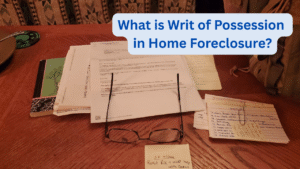 What Is a Writ of Possession in a Home Foreclosure?
What Is a Writ of Possession in a Home Foreclosure?
When a home goes through foreclosure, it’s not always the end of the process for the homeowner. Even after the property is sold at auction or repossessed by the lender, the former homeowner—or other occupants—may still be living in the property. In such cases, the new owner must take legal steps to gain full possession of the home. One of those steps is requesting a Writ of Possession.
Understanding what a Writ of Possession is and how it works is essential for both former homeowners and real estate investors dealing with foreclosure properties.
What Is a Writ of Possession?
A Writ of Possession is a legal court order that authorizes law enforcement—typically the local sheriff or constable—to remove occupants from a property. It is used in home foreclosure situations when the people living in the foreclosed property refuse to vacate after the home has been legally sold or repossessed.
The writ gives the new legal owner the right to take physical and legal possession of the home.
When Is a Writ of Possession Used?
A Writ of Possession is typically used after the foreclosure sale has concluded and the new owner has taken title to the property—whether that be the lender, a real estate investor, or another buyer.
If the current occupants do not leave voluntarily after receiving a Notice to Vacate, the new owner can go to court and file a motion to obtain a Writ of Possession. Once the writ is issued, law enforcement is empowered to carry out an eviction.
The Process of Obtaining a Writ of Possession
Here’s how the process typically unfolds:
-
Foreclosure Sale Completion
The foreclosure process ends with a public sale or auction, Then the property is transferred to a new owner.
-
Notice to Vacate Issued
The new owner usually provides a written notice asking the current occupants to vacate the property within a specific time frame (commonly 3–30 days, depending on the state).
-
Legal Action for Possession
If the occupants don’t leave by the deadline, the new owner files for a Writ of Possession in the local court.
-
Court Issues the Writ
After reviewing the case, the court grants the writ. It is then handed over to the sheriff’s department.
-
Sheriff Posts Final Notice
The sheriff posts a notice at the property, often giving the occupants a final 24 to 72 hours to leave.
-
Eviction Enforced
If the occupants are still present after the notice period, law enforcement arrives, removes them, and ensures the property is secured.
Legal Rights and Considerations
Former homeowners and tenants do have rights in this process. In some cases, occupants may attempt to delay the eviction by filing motions in court or declaring bankruptcy, which may temporarily halt the issuance of the writ.
However, once a Writ of Possession is lawfully granted, law enforcement will proceed with the eviction unless a valid legal challenge is upheld by the court.
Why It Matters for New Property Owners
For investors or banks acquiring foreclosed properties, obtaining a Writ of Possession is often the final step in securing their investment. Until they gain physical control of the property, they cannot renovate, sell, or rent it. Understanding the legal process ensures a smoother and faster transition to ownership.
Frequently Asked Questions (FAQ)
1. How long does it take to get a Writ of Possession after foreclosure?
The timeline varies by state, but typically it can take a few days to a few weeks after the new owner files for the writ, depending on court schedules and whether occupants contest the eviction.
2. Can a homeowner fight a Writ of Possession?
Yes, but only under certain legal grounds—such as proving improper foreclosure procedures or filing for bankruptcy protection. These actions may delay but rarely stop eviction unless the court finds merit.
3. Do tenants have any rights after a foreclosure?
Yes. Under the Protecting Tenants at Foreclosure Act, bona fide tenants may be allowed to stay in the property for at least 90 days after foreclosure or until the end of their lease, depending on the situation.
4. Will the sheriff physically remove me from the home?
If you remain in the home after the notice period ends yes. The sheriff is legally authorized to remove you and secure the property for the new owner.
5. Can the new owner skip the Writ of Possession process?
No. Even if the new owner holds the deed, they cannot forcibly remove occupants without a court-issued Writ of Possession. Doing so without legal authorization is considered illegal eviction.
6. Does receiving a Writ of Possession hurt my credit?
The writ itself does not appear on your credit report. However, the foreclosure process that preceded it likely does. It can significantly impact your credit score for up to seven years.
Conclusion:
A Writ of Possession is a crucial legal tool that finalizes a foreclosure. It grants the new property owner the right to legally take control. For former homeowners, understanding the process can help them make informed decisions. For buyers, it’s an important step in securing access to their newly acquired real estate investment.